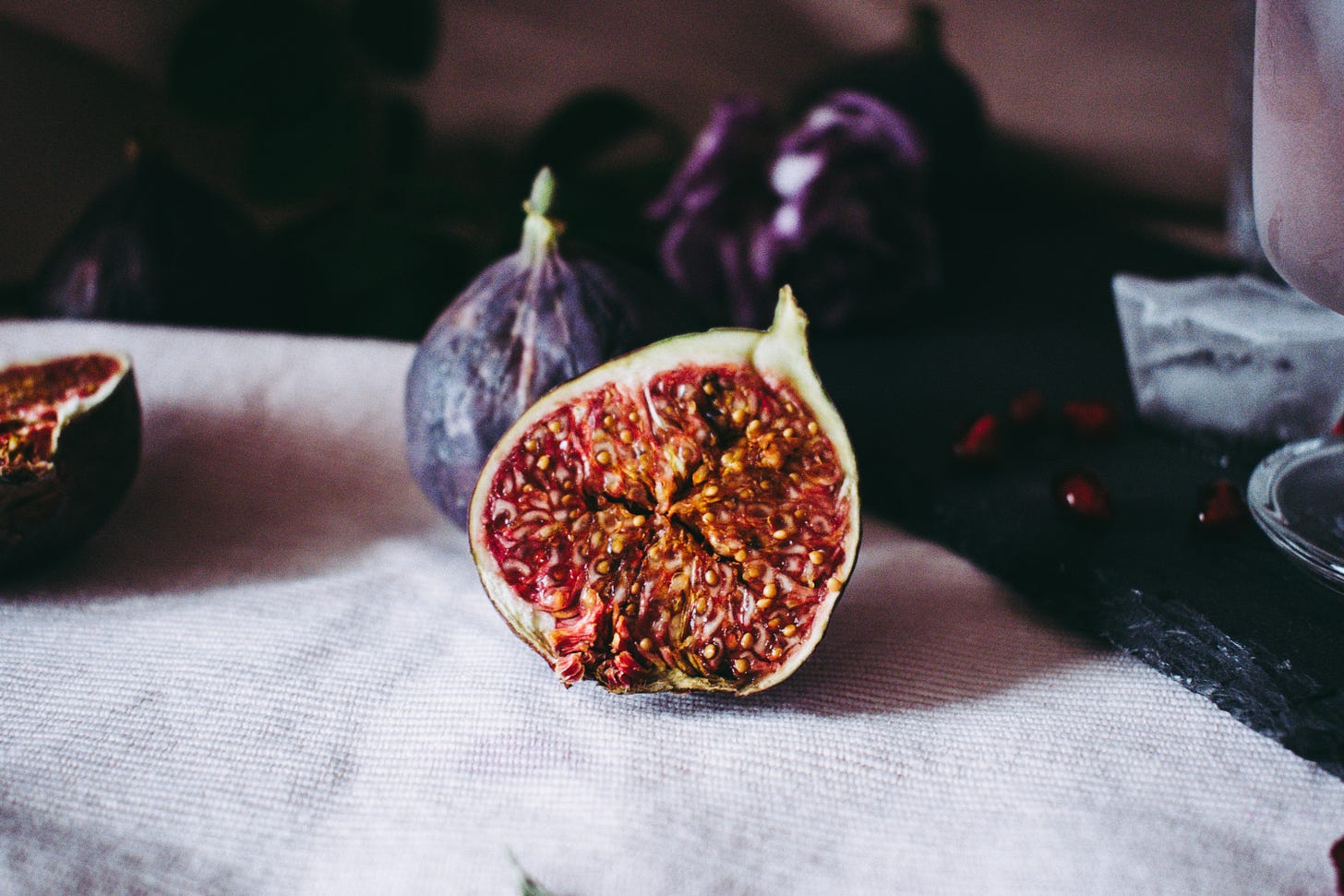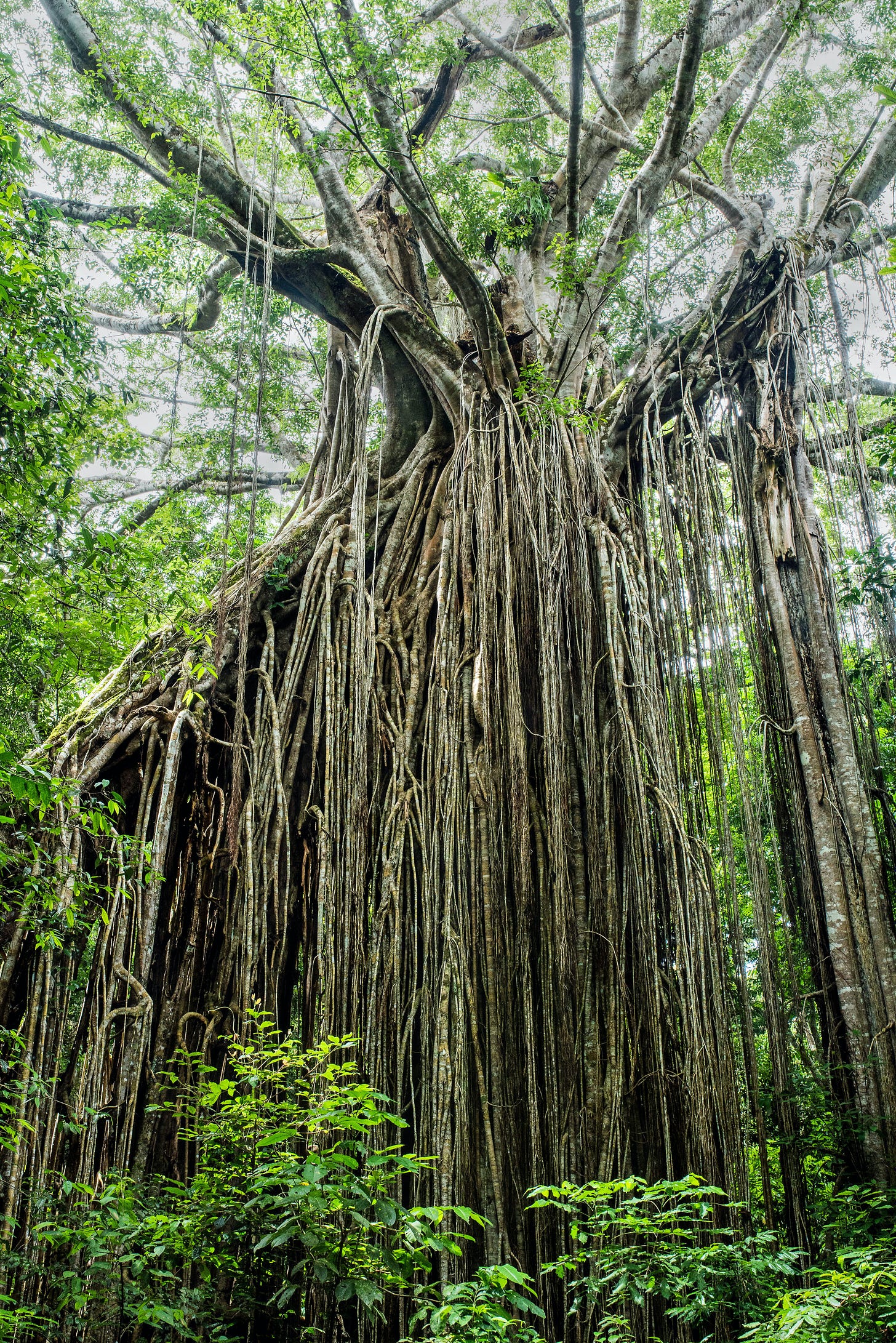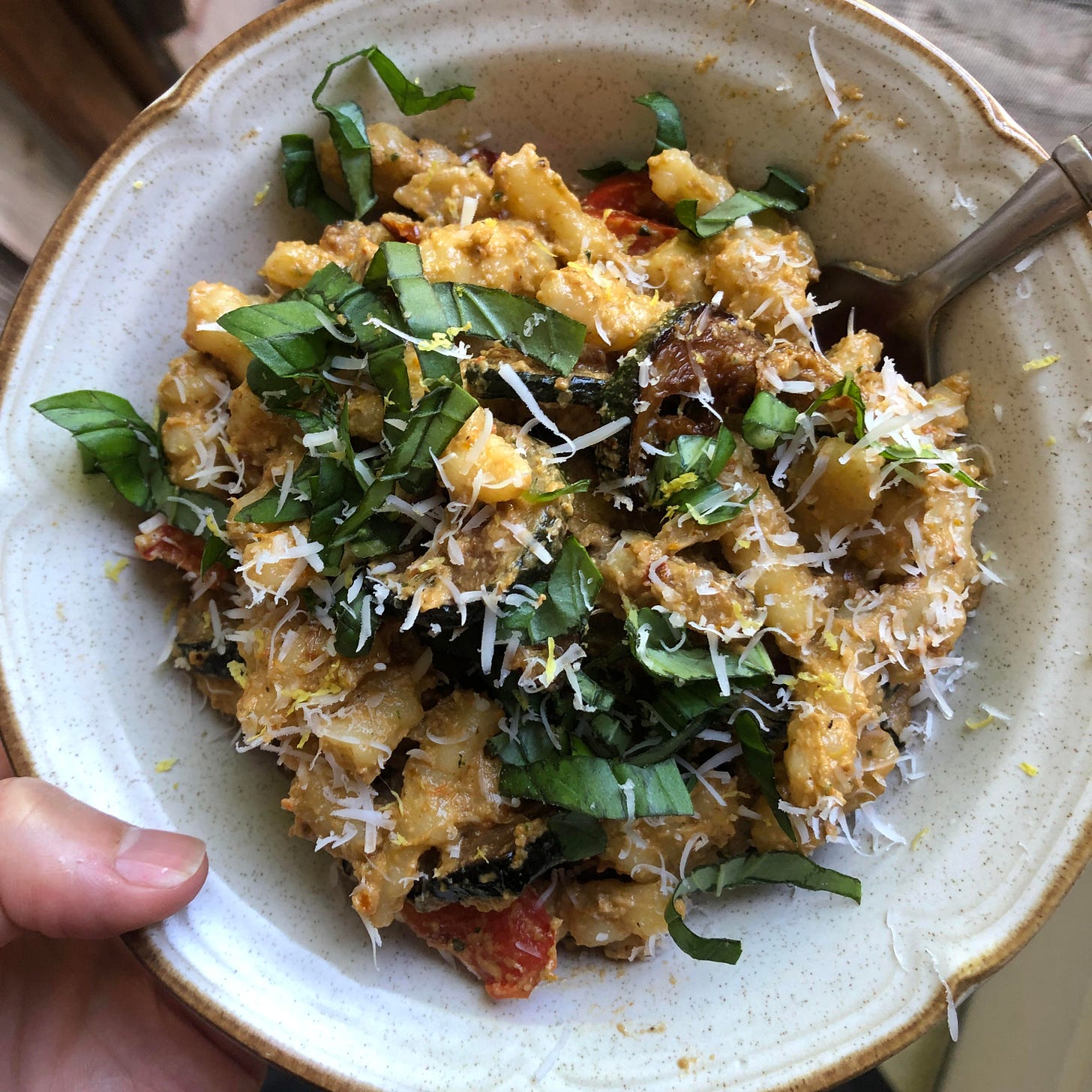Note: Having difficulties with my microphone— will get the recording up as soon as I get the chance!
I love figs, so much so that I now carry them with me everywhere I go in the form of a tattoo.
Of course there is the obvious reason to love figs: they are delicious. Whether fresh, dried, or cooked, they are generously plumy and sweet. That said, I am very particular about fresh figs and, because of this, usually only eat them at certain times and in certain places. I’m too sensitive to handle the disappointment of unripe fruit. Dried figs, on the other hand, I have no reservations about. I will eat them anywhere and have been known to hunt them down in markets, train stations and airports around the world. There have been times when my definition of abundance was a travel bag stuffed with dried figs.
Beyond their assimilable delights, my love for figs is hard to explain. For starters, I think it is a love that has lots to do with the multispecies relationships that figs foster. I’ll never be able to account for all of their intimate encounters, but I know enough to at least appreciate some of the ways they shape the world.
There are about 750 Ficus varieties that have influenced the planet for millions of years. As fig-enthusiast and ecologist Mike Shanahan notes, if you go back far enough, we–humans, that is–are all descendents from fig-eaters. Our manual dexterity might even be attributed to checking a fig’s ripeness. I love knowing that we may have figs to thank for our opposable thumbs; that, above all, thumbs were intended for plucking and pressing soft little fruits.
Fig trees– or ficus– are what is called a keystone species. Just as a keystone on a bridge secures all the other stones in place, figs are integral to the structure of tropical forests. Remove them, and this could trigger a cascade of local extinctions as birds, monkeys and fruit bats starve and are no longer around to disperse the seeds of thousands of other plant species (Shanahan 75).
This critical ecological role that fig trees play has long been recognized in human culture. Before ficus was called a keystone by biologists, people knew of their importance. Figs feature in a stunning amount of creation stories. There is the more widespread Judeo-Christan creation story wherein, some versions say, the forbidden fruit was a fig (though I have read writers who insist it was a quince!). But there are countless other beginnings in which figs feature prominently, including that of Persian mythology wherein Mithra ate a fig for his first meal. In the Congo basin, the first hunter is said to have been born from a species of fig. There are more still, such as the creation stories of the Kuyuku people of Kenya, and the Kutia Kondh people of Odisha, India.
Beyond creation stories figs are integral in other kinds of cultural narratives, often as a home for spirits and departed kin. On the island of Borneo, the Iban and other Indigenous peoples traditionally prohibit felling strangler figs because spirits dwell among their many tangled roots and branches. In Hong Kong, two Ficus microcarpa have become famous as “wishing trees.”
Photo by David Clode on Unsplash
Given how many bodies, beliefs, and beginnings figs nourish, the significance and potential of figs is not hard to glean. It may, therefore, come as no surprise that after a devastating ecological event, like a volcanic eruption, they are one of the first to return, or that they are integral to community-based rainforest restoration projects in parts of Southeast Asia and elsewhere. Their persistence in making landscapes more livable and fortifying them against climate catastrophe has been known by the people and other-than-human animals who’ve spent time–millennia and more– with them.
Closer to home, common varieties of fig trees can even withstand harsh winters. In Ontario, Quebec, New York, and surely other provinces and states too, they can survive buried under snow. My mom’s parents used to overwinter fig trees– another way figs have endeared themselves to me. It’s a common practice for Italians outside of Italy and anyone else who loves figs, I’m sure. But it is a lot of work. I’m told that in the fall, before the ground froze, my nonno used to dig up his little garden, lay the fig tree down on their side, and tuck them under a cozy blanket of dirt until spring.
I tried to figure out why, year after year, people went to the trouble to bury and unearth these trees. My zia–though not by blood–told me that it was “because they loved them,” which is as good a reason as any for doing something difficult, but one that also affirms the place of figs as cultural linchpin.
It seems that, across various contexts and in different ways, figs offer comfort and kinship that is both immeasurable and deeply tangible. It is not only their edibility that makes them important, but also, their company.
Overwintering and planting fig trees for restoration projects begins to signal the considerable amount of human labour that goes into caring for the trees. However, this is not the only kind of labour required to keep figs alive. Actually, for the species, human labour is quite inconsequential in comparison to the work that non-human animals do to spread seeds.
And then there is the fig wasp. Simply put, without the wasp, the fig’s magic would not be.
Fig wasps are tiny– only about 2mm long, with wings thinner than a human hair. They are itty bitty and so very unlike the yellowjackets and hornets that quickly ruin a picnic. The short adult life of the fig wasp can only be sustained for about an hour or so, and it is spent traveling from one fig to another. There is a whole complex process that Shanahan describes in detail in his book about fig wasps and their role in pollinating figs. It is a timely and specific process: they emerge from one fig to seek out another, specific kind of ficus, with flowers (figs) at a specific stage of ripeness. To pollinate these figs, the wasp must crawl inside a tiny hole in the fruit. In the process of crawling inside, the wasp loses their wings. They won’t need them again. Once they do their work, the wasp will die inside the fig, in the familiar place wherein they were born. Quickly, the fig will break the body down and repurpose the protein.
There is something about this relationship between fig and wasp that I come back to again and again, with lots of mixed feelings. There is awe, sadness, confusion and deep affection. The lengths that wasps (and people!) will go to for figs is, at once, beautiful, curious and unsettling. Reflecting on this requires me to sit with complicated affect, which brings me the thorny bit of my love for figs.
The first time I learned about the complicated fig-fig wasp relationship was in the early-mid 2010s, when figs divided vegans on the internet. It was a weird time; a time long before oat milk was available at Starbucks and Beyond Meat at A&W, when raw veganism and RawTill4 were big, and when every vegan who watched YouTube knew who Freelee the Banana Girl was. Fruit was, predictably, a big topic of conversation. The big question was: as “carnivores” themselves, do figs count as vegan?
Whether or not figs are vegan–or any other carnivorous plants– may seem a bit absurd, especially to an omnivore, but it is actually an interesting question, especial for a vegan who has feelings about veganism (my good friend Marika and I talk about this a bit in “On the Possibilities of Queer Vegan Pleasure). I’m not interested in debating the imagined moral weight of eating figs, which was largely at the core of the internet fig crusades of the last decade. Rather, what I’m most interested in is how figs trouble what veganism, or, more specifically, what gets called veganism, claims to center, which is often the idyllic idea that one can entirely avoid doing harm if they follow a set of dietary rules and, moreover, that harm is clear, singular, easy to understand and easy to avoid.
But when a fig wasp’s entire existence hinges on the presence of the thing that kills it, harm is much harder to discern, especially when one takes into account the long history of this relationship and its integral role in supporting diverse life. By considering these nuances, it becomes much clearer that what I may call harm is very much shaped by my humanness (which includes the social and cultural environments in which that being has been molded).
That was a bit tangential but it is all to say that I’m curious about how figs present a sticking point from which to consider the complicated feelings that might come up when harm is acknowledged. Cree poet Billy-Ray Belcourt writes, “negative affect isn’t always bad for us, and if we incorporate [it] into our social theories of protest we might more honestly render the contours of being in a body that has inherited the racialized violence of being left to sit in the air like an unanswered question” (183). Here, he is writing specifically about queer Indigeneity. Moreover, I came to this quote in Gage Karahkwí:io Diabo’s “Bad feelings, feeling bad: the affects of Asian-Indigenous coalition,” which I was reading for dissertation research. I mention this because I am still working to contextualize these ideas more thoroughly, especially in terms of how they relate to the affective dimensions of food and eating. However, I also want to acknowledge how these works are helping me begin to consider the vitality of bad feelings in relation to food and how these affective responses lie “off the beaten path of Eurocentric notions of liberty and progress” (Diabo).
These aren’t fully formed critiques but I’m thinking specifically about our culture’s faith in the idea that corporate interests and individual consumer choices– the free market, in other words– will one day “fix” the problems of food insecurity and environmental degradation, which are currently having devastating impacts to communities around the globe.
I’m thinking about how, when writers critique meat alternatives like Beyond Meat and Impossible Foods– or other plant-based products being peddled by big corporations who care more about profit than people and planet– their legitimate and well supported concerns are dismissed as pessimism, negativity, or cynicism. To be clear, these writers’ reasonable concerns about access, agriculture and labour practices are dismissed as cynicism. This dismissal says that their “negativity,” their “bad feeling,” is the problem that needs fixing and not the practices that enable violence to begin with. Returning to Belcourt’s quote, these kinds of dismissals are also a refusal to engage with the ways that food systems continue to perpetuate racialized violence by exploiting the lands and labour of peoples who have been systematically dispossessed. It feels especially important to center the critical potential of bad feelings this month of July during which both so-called Canada and the U.S. continue to celebrate colonial genecide and the theft of lands upon which food is produced, often unkindly.
I don’t want to end this by moving past bad feelings. Rather, I’ll return to figs and the kind of care they demonstrate in the face of bad feelings.
The unsettling realization that a wasp probably died inside the fig you’re enjoying (but also the main reason why the fig exists to begin with) might bring up the tickling of disgust or sadness. However, the reason you don’t bite into wasp bits while enjoying that fig is because of ficin, which is an enzyme that breaks down tough protein and repurposes it.
The texture and form of the wasp changes thanks to an ancient, reiterative agreement between fig and wasp that lends tenderness, quite literally, to the unsavory process of ingestion.
References:
Belcourt, Billy-Ray. “Indigenous Studies Beside Itself.” Somatechnics 7 (2): 182–184. 2017
Diabo, Gage Karahkwí:io. “Bad feelings, feeling bad: the affects of Asian-Indigenous coalition,” Inter-Asia Cultural Studies, 20:2, 257-270, 2019.
Shanahan, Mike. Gods, Wasps and Stranglers: The Secret History and Redemptive Future of Fig Trees. Chelsea Green Publishing, 2016.
Reading
What I finished in June:
Tender is the Flesh by Augustina Bazterrica
CW: sexual violence
A post-apocalyptic type novel in which animal meat is contaminated and is replaced by human meat. It is a short but heavy read.
A Short History of Spaghetti with Tomato Sauce by Massimo Montanari
Exactly as it sounds! Also, this Montanari is not related to me (that I know of).
The Bell Jar by Sylvia Plath
CW: self-harm, a bunch of casual racism that was probably dismissed in your English class as “a reflection of the times”
I had the urge to revisit this novel, probably because of one very specific fig tree reference that I’ve always loved.
Gods, Wasps, and Stranglers: The Secret History and Redemptive Future of Fig Trees by Mike Shanahan
This book offers a comprehensive look at fig trees around the world. I really appreciate Shanahan’s effort to make dense scientific work more accessible.
Cooking
Pasta, which you know if you follow me on Instagram. I’ve been making my noodles from scratch and it is such work! Pictured below is a vegan sun-dried tomato pesto.
Podcast
Mike Shanahan talking about figs with Jessamine Starr on Fruit Love Letters “The Fig-Mother of All Fruit” by Whetstone Radio Collective– This is a good quick (and free) dive into many of the topics Shanahan covers in his book, Gods, Wasps and Stranglers.






